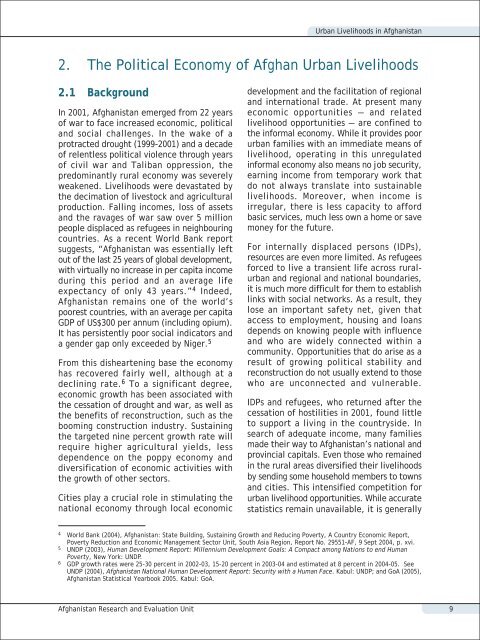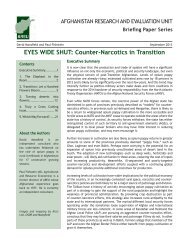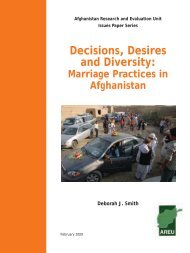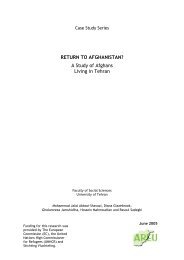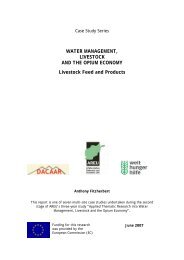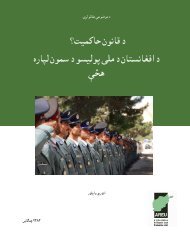Urban Livelihoods in Afghanistan - the Afghanistan Research and ...
Urban Livelihoods in Afghanistan - the Afghanistan Research and ...
Urban Livelihoods in Afghanistan - the Afghanistan Research and ...
You also want an ePaper? Increase the reach of your titles
YUMPU automatically turns print PDFs into web optimized ePapers that Google loves.
<strong>Urban</strong> <strong>Livelihoods</strong> <strong>in</strong> <strong>Afghanistan</strong>2. The Political Economy of Afghan <strong>Urban</strong> <strong>Livelihoods</strong>2.1 BackgroundIn 2001, <strong>Afghanistan</strong> emerged from 22 yearsof war to face <strong>in</strong>creased economic, political<strong>and</strong> social challenges. In <strong>the</strong> wake of aprotracted drought (1999-2001) <strong>and</strong> a decadeof relentless political violence through yearsof civil war <strong>and</strong> Taliban oppression, <strong>the</strong>predom<strong>in</strong>antly rural economy was severelyweakened. <strong>Livelihoods</strong> were devastated by<strong>the</strong> decimation of livestock <strong>and</strong> agriculturalproduction. Fall<strong>in</strong>g <strong>in</strong>comes, loss of assets<strong>and</strong> <strong>the</strong> ravages of war saw over 5 millionpeople displaced as refugees <strong>in</strong> neighbour<strong>in</strong>gcountries. As a recent World Bank reportsuggests, “<strong>Afghanistan</strong> was essentially leftout of <strong>the</strong> last 25 years of global development,with virtually no <strong>in</strong>crease <strong>in</strong> per capita <strong>in</strong>comedur<strong>in</strong>g this period <strong>and</strong> an average lifeexpectancy of only 43 years.” 4 Indeed,<strong>Afghanistan</strong> rema<strong>in</strong>s one of <strong>the</strong> world’spoorest countries, with an average per capitaGDP of US$300 per annum (<strong>in</strong>clud<strong>in</strong>g opium).It has persistently poor social <strong>in</strong>dicators <strong>and</strong>a gender gap only exceeded by Niger. 5.........From this dishearten<strong>in</strong>g base <strong>the</strong> economyhas recovered fairly well, although at adecl<strong>in</strong><strong>in</strong>g rate. 6 To a significant degree,economic growth has been associated with<strong>the</strong> cessation of drought <strong>and</strong> war, as well as<strong>the</strong> benefits of reconstruction, such as <strong>the</strong>boom<strong>in</strong>g construction <strong>in</strong>dustry. Susta<strong>in</strong><strong>in</strong>g<strong>the</strong> targeted n<strong>in</strong>e percent growth rate willrequire higher agricultural yields, lessdependence on <strong>the</strong> poppy economy <strong>and</strong>diversification of economic activities with<strong>the</strong> growth of o<strong>the</strong>r sectors.Cities play a crucial role <strong>in</strong> stimulat<strong>in</strong>g <strong>the</strong>national economy through local economicdevelopment <strong>and</strong> <strong>the</strong> facilitation of regional<strong>and</strong> <strong>in</strong>ternational trade. At present manyeconomic opportunities — <strong>and</strong> relatedlivelihood opportunities — are conf<strong>in</strong>ed to<strong>the</strong> <strong>in</strong>formal economy. While it provides poorurban families with an immediate means oflivelihood, operat<strong>in</strong>g <strong>in</strong> this unregulated<strong>in</strong>formal economy also means no job security,earn<strong>in</strong>g <strong>in</strong>come from temporary work thatdo not always translate <strong>in</strong>to susta<strong>in</strong>ablelivelihoods. Moreover, when <strong>in</strong>come isirregular, <strong>the</strong>re is less capacity to affordbasic services, much less own a home or savemoney for <strong>the</strong> future.For <strong>in</strong>ternally displaced persons (IDPs),resources are even more limited. As refugeesforced to live a transient life across ruralurban<strong>and</strong> regional <strong>and</strong> national boundaries,it is much more difficult for <strong>the</strong>m to establishl<strong>in</strong>ks with social networks. As a result, <strong>the</strong>ylose an important safety net, given thataccess to employment, hous<strong>in</strong>g <strong>and</strong> loansdepends on know<strong>in</strong>g people with <strong>in</strong>fluence<strong>and</strong> who are widely connected with<strong>in</strong> acommunity. Opportunities that do arise as aresult of grow<strong>in</strong>g political stability <strong>and</strong>reconstruction do not usually extend to thosewho are unconnected <strong>and</strong> vulnerable.IDPs <strong>and</strong> refugees, who returned after <strong>the</strong>cessation of hostilities <strong>in</strong> 2001, found littleto support a liv<strong>in</strong>g <strong>in</strong> <strong>the</strong> countryside. Insearch of adequate <strong>in</strong>come, many familiesmade <strong>the</strong>ir way to <strong>Afghanistan</strong>’s national <strong>and</strong>prov<strong>in</strong>cial capitals. Even those who rema<strong>in</strong>ed<strong>in</strong> <strong>the</strong> rural areas diversified <strong>the</strong>ir livelihoodsby send<strong>in</strong>g some household members to towns<strong>and</strong> cities. This <strong>in</strong>tensified competition forurban livelihood opportunities. While accuratestatistics rema<strong>in</strong> unavailable, it is generally4 World Bank (2004), <strong>Afghanistan</strong>: State Build<strong>in</strong>g, Susta<strong>in</strong><strong>in</strong>g Growth <strong>and</strong> Reduc<strong>in</strong>g Poverty, A Country Economic Report,Poverty Reduction <strong>and</strong> Economic Management Sector Unit, South Asia Region, Report No. 29551-AF, 9 Sept 2004, p. xvi.5 UNDP (2003), Human Development Report: Millennium Development Goals: A Compact among Nations to end HumanPoverty, New York: UNDP.6 GDP growth rates were 25-30 percent <strong>in</strong> 2002-03, 15-20 percent <strong>in</strong> 2003-04 <strong>and</strong> estimated at 8 percent <strong>in</strong> 2004-05. SeeUNDP (2004), <strong>Afghanistan</strong> National Human Development Report: Security with a Human Face. Kabul: UNDP; <strong>and</strong> GoA (2005),<strong>Afghanistan</strong> Statistical Yearbook 2005. Kabul: GoA.<strong>Afghanistan</strong> <strong>Research</strong> <strong>and</strong> Evaluation Unit 9


